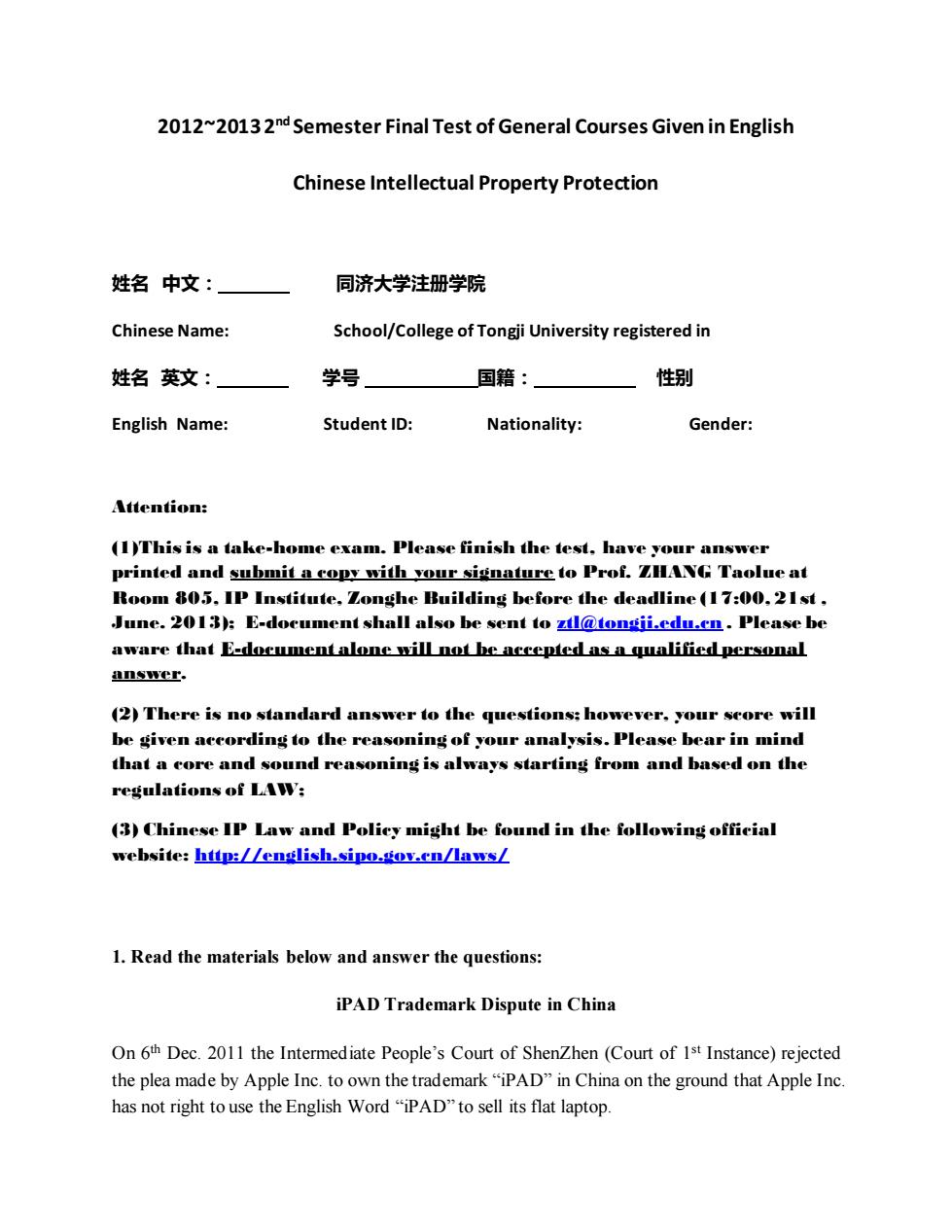
2012~2013 2nd Semester Final Test of General Courses Given in English Chinese Intellectual Property Protection 姓名中文: 同济大学注册学院 Chinese Name School/College of Tongji University registered in 姓名英文:」 学号 国籍:」 性别 English Name: Student ID: Nationality: Gender: Attention: (I)This is a take-home exam.Please finish the test,have your answer printed and submit a copy with your signature to Prof.ZHANG Taolue at Room 805.IP Institute.Zonghe Building before the deadline (17:00.21st, June.2013):E-document shall also be sent to zil@fongii.cdu.cn.Please be aware that E-documentalone will not be accepted as a qualified personal answer. (2)There is no standard answer to the questions:however.your seore will be e given according to the reasoning of your analysis.Please h ear in mind that a core and sound reasoning is always starting from and based on the regulations of LAW: (3)Chinese IP Law and Poliey might be found in the following official website:http://english.sipo.tov.cn/laws/ 1.Read the materials below and answer the questions: iPAD Trademark Dispute in China On6hDec.2011 the Intermediate People's Court of ShenZhen(Court of 1st Instance)rejected the plea made by Apple Inc.to own the trademark"iPAD"in China on the ground that Apple Inc has not right to use the English Word"iPAD"to sell its flat laptop
2012~20132 nd Semester Final Test of General Courses Given in English Chinese Intellectual Property Protection 姓名 中文: 同济大学注册学院 Chinese Name: School/College of Tongji University registered in 姓名 英文: 学号 国籍: 性别 English Name: Student ID: Nationality: Gender: Attention: (1)This is a take-home exam. Please finish the test, have your answer printed and submit a copy with your signature to Prof. ZHANG Taolue at Room 805, IP Institute, Zonghe Building before the deadline (17:00, 21st , June. 2013); E-document shall also be sent to ztl@tongji.edu.cn . Please be aware that E-document alone will not be accepted as a qualified personal answer. (2) There is no standard answer to the questions; however, your score will be given according to the reasoning of your analysis. Please bear in mind that a core and sound reasoning is always starting from and based on the regulations of LAW; (3) Chinese IP Law and Policy might be found in the following official website: http://english.sipo.gov.cn/laws/ 1. Read the materials below and answer the questions: iPAD Trademark Dispute in China On 6th Dec. 2011 the Intermediate People’s Court of ShenZhen (Court of 1st Instance) rejected the plea made by Apple Inc. to own the trademark “iPAD” in China on the ground that Apple Inc. has not right to use the English Word “iPAD” to sell its flat laptop
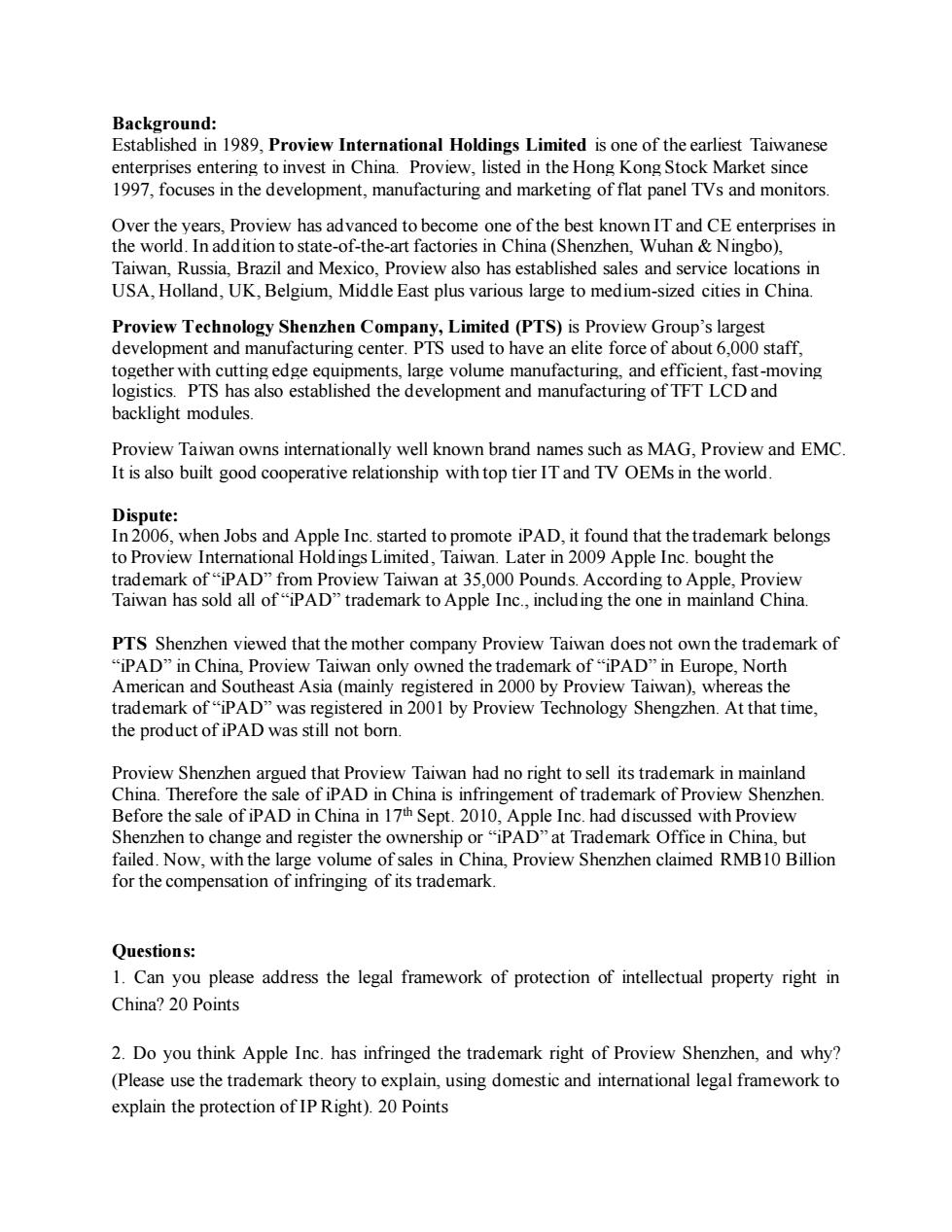
Background: Established in 1989,Proview International Holdings Limited is one of the earliest Taiwanese enterprises entering to invest in China.Proview,listed in the Hong Kong Stock Market since 1997,focuses in the development,manufacturing and marketing of flat panel TVs and monitors. Over the Proview has advanced to become one of the best knownIT and enterprises in the world.In addition to state-of-the-art factories in China (Shenzhen.Wuhan Ningbo). Taiwan,Russia,Brazil and Mexico,Proview also has established sales and service locations in USA,Holland,UK,Belgium,Middle East plus various large to medium-sized cities in China. Proview Technology Shenzhen Com and m any,Limited (PTS)is Proview Group's largest pme elite force of al It 6.000 staff ogether with Ting edge development Proview Taiwan owns internationally well known brand names such as MAG,Proview and EMC It is also built good cooperative relationship with top tier IT and TV OEMs in the world. Dis In 2006.when Jobs a nd An ple Inc.started to note iPAD.it found that the trademark belongs Inte al Ho ngs ed Apple In. h ght the at 5.000 Pounds Ac demark to Apple Inc.,including the one in r Apple,P PTS Shenzhen viewed that the mother company Proview Taiwan does not own the trademark of iPAD”inCh na,Proview Taiwan only owned the trademark of"iPAD"in Europe,North American and Southeast Asia(mainly registered in 2000 by Proview Taiwan),whereas the trademark of"iPAD"was registered in 2001 by Proview Technology Shengzhen.At that time, the product of iPAD was still not born. Proview Shenzhen argued that Proview Taiwan had no right to sell its trademark in mainland China.Therefore the sale of iPAD in China is infringement of trademark of Proview Shenzhen. Before the sale of iPAD in China in 17th Sept.2010,Apple Inc.had discussed with Proview Shenzhen to change and register the ownership or"iPAD"at Trademark Office in China.but failed.Now,with the larg olume of sales in China,Proview Shenzhen claimed RMB10 Billion for the co mpensation of infringing of its trademark. Questions: 1.Can you please address the legal framework of protection of intellectual property right in China?20 Points 2.Do you think Apple Inc.has infringed the trademark right of Proview Shenzhen,and why? (Please use the trademark theory to explain,using domestic and intemational legal framework to explain the protection of IP Right).20 Points
Background: Established in 1989, Proview International Holdings Limited is one of the earliest Taiwanese enterprises entering to invest in China. Proview, listed in the Hong Kong Stock Market since 1997, focuses in the development, manufacturing and marketing of flat panel TVs and monitors. Over the years, Proview has advanced to become one of the best known IT and CE enterprises in the world. In addition to state-of-the-art factories in China (Shenzhen, Wuhan & Ningbo), Taiwan, Russia, Brazil and Mexico, Proview also has established sales and service locations in USA, Holland, UK, Belgium, Middle East plus various large to medium-sized cities in China. Proview Technology Shenzhen Company, Limited (PTS) is Proview Group’s largest development and manufacturing center. PTS used to have an elite force of about 6,000 staff, together with cutting edge equipments, large volume manufacturing, and efficient, fast-moving logistics. PTS has also established the development and manufacturing of TFT LCD and backlight modules. Proview Taiwan owns internationally well known brand names such as MAG, Proview and EMC. It is also built good cooperative relationship with top tier IT and TV OEMs in the world. Dispute: In 2006, when Jobs and Apple Inc. started to promote iPAD, it found that the trademark belongs to Proview International Holdings Limited, Taiwan. Later in 2009 Apple Inc. bought the trademark of “iPAD” from Proview Taiwan at 35,000 Pounds. According to Apple, Proview Taiwan has sold all of “iPAD” trademark to Apple Inc., including the one in mainland China. PTS Shenzhen viewed that the mother company Proview Taiwan does not own the trademark of “iPAD” in China, Proview Taiwan only owned the trademark of “iPAD” in Europe, North American and Southeast Asia (mainly registered in 2000 by Proview Taiwan), whereas the trademark of “iPAD” was registered in 2001 by Proview Technology Shengzhen. At that time, the product of iPAD was still not born. Proview Shenzhen argued that Proview Taiwan had no right to sell its trademark in mainland China. Therefore the sale of iPAD in China is infringement of trademark of Proview Shenzhen. Before the sale of iPAD in China in 17th Sept. 2010, Apple Inc. had discussed with Proview Shenzhen to change and register the ownership or “iPAD” at Trademark Office in China, but failed. Now, with the large volume of sales in China, Proview Shenzhen claimed RMB10 Billion for the compensation of infringing of its trademark. Questions: 1. Can you please address the legal framework of protection of intellectual property right in China? 20 Points 2. Do you think Apple Inc. has infringed the trademark right of Proview Shenzhen, and why? (Please use the trademark theory to explain, using domestic and international legal framework to explain the protection of IP Right). 20 Points
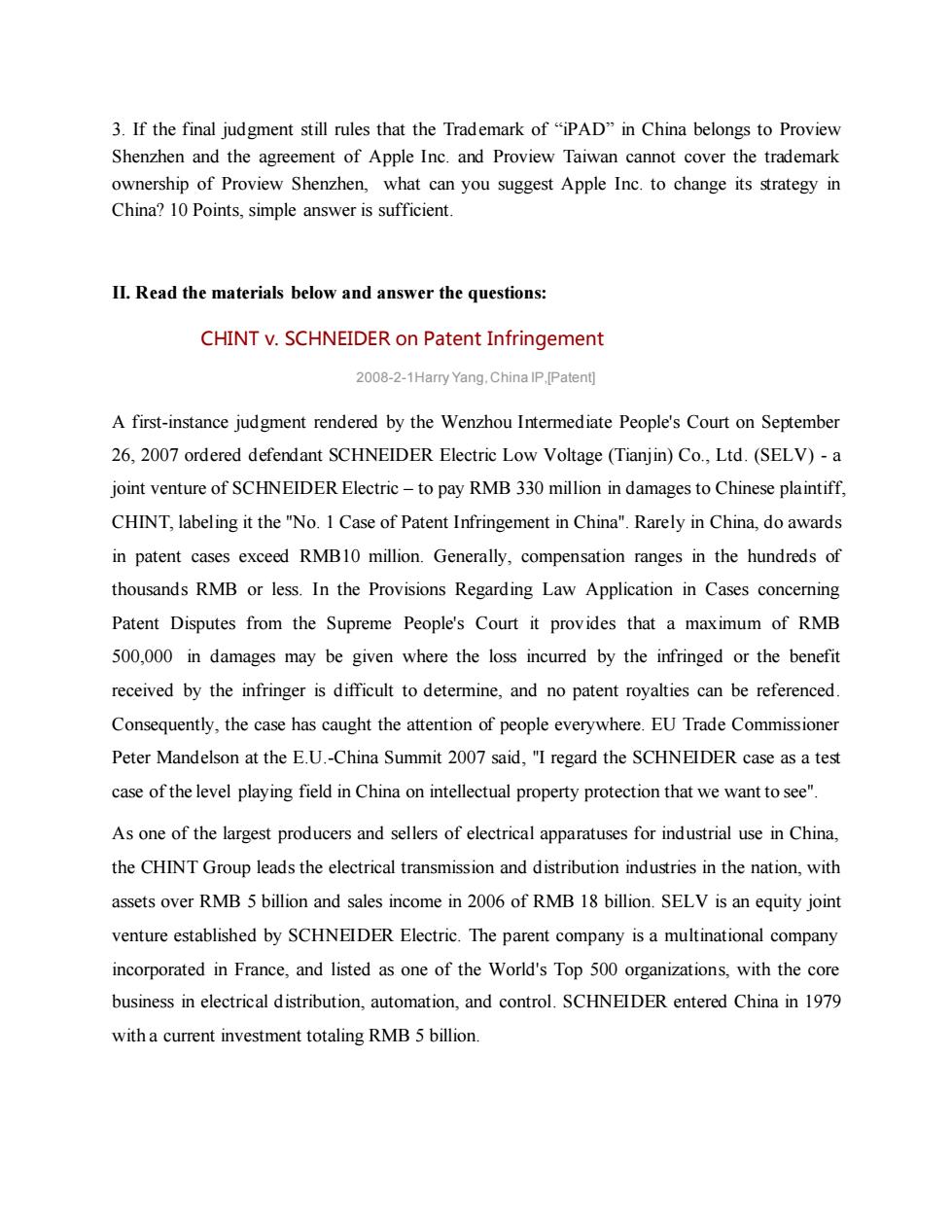
3.If the final judgment still rules that the Trademark of"iPAD"in China belongs to Proview Shenzhen and the agreement of Apple Inc.and Proview Taiwan cannot cover the trademark ownership of Proview Shenzhen,what can you suggest Apple Inc.to change its strategy in China?10 Points,simple answer is sufficient. II.Read the materials below and answer the questions: CHINT v.SCHNEIDER on Patent Infringement 2008-2-1Harry Yang.China IP.Patent] A first-instance judgment rendered by the Wenzhou Intermediate People's Court on September 26,2007 ordered defendant SCHNEIDER Electric Low Voltage(Tianjin)Co.,Ltd.(SELV)-a joint venture of SCHNEIDER Electric-to pay RMB 330 million in damages to Chinese plaintiff, CHINT,labeling it the"No.1 Case of Patent Infringement in China".Rarely in China,do awards in patent cases exceed RMB10 million.Generally,compensation ranges in the hundreds of thousands RMB or less.In the Provisions Regarding Law Application in Cases concering Patent Disputes from the Supreme People's Court it provides that a maximum of RMB 500,000 in damages may be given where the loss incurred by the infringed or the benefit received by the infringer is difficult to determine,and no patent royalties can be referenced. Consequently.the case has caught the attention of people everywhere.EU Trade Commissioner Peter Mandelson at the E.U.-China Summit 2007 said,"I regard the SCHNEIDER case as a test case of the level playing field in China on intellectual property protection that we want to see" As one of the largest producers and sellers of electrical apparatuses for industrial use in China, the CHINT Group leads the electrical transmission and distribution industries in the nation,with assets over RMB 5 billion and sales income in 2006 of RMB 18 billion.SELV is an equity joint venture established by SCHNEIDER Electric.The parent company is a multinational company incorporated in France,and listed as one of the World's Top 500 organizations,with the core business in electrical distribution,automation,and control.SCHNEIDER entered China in 1979 with a current investment totaling RMB 5 billion
3. If the final judgment still rules that the Trademark of “iPAD” in China belongs to Proview Shenzhen and the agreement of Apple Inc. and Proview Taiwan cannot cover the trademark ownership of Proview Shenzhen, what can you suggest Apple Inc. to change its strategy in China? 10 Points, simple answer is sufficient. II. Read the materials below and answer the questions: CHINT v. SCHNEIDER on Patent Infringement 2008-2-1Harry Yang, China IP,[Patent] A first-instance judgment rendered by the Wenzhou Intermediate People's Court on September 26, 2007 ordered defendant SCHNEIDER Electric Low Voltage (Tianjin) Co., Ltd. (SELV) - a joint venture of SCHNEIDER Electric – to pay RMB 330 million in damages to Chinese plaintiff, CHINT, labeling it the "No. 1 Case of Patent Infringement in China". Rarely in China, do awards in patent cases exceed RMB10 million. Generally, compensation ranges in the hundreds of thousands RMB or less. In the Provisions Regarding Law Application in Cases concerning Patent Disputes from the Supreme People's Court it provides that a maximum of RMB 500,000 in damages may be given where the loss incurred by the infringed or the benefit received by the infringer is difficult to determine, and no patent royalties can be referenced. Consequently, the case has caught the attention of people everywhere. EU Trade Commissioner Peter Mandelson at the E.U.-China Summit 2007 said, "I regard the SCHNEIDER case as a test case of the level playing field in China on intellectual property protection that we want to see". As one of the largest producers and sellers of electrical apparatuses for industrial use in China, the CHINT Group leads the electrical transmission and distribution industries in the nation, with assets over RMB 5 billion and sales income in 2006 of RMB 18 billion. SELV is an equity joint venture established by SCHNEIDER Electric. The parent company is a multinational company incorporated in France, and listed as one of the World's Top 500 organizations, with the core business in electrical distribution, automation, and control. SCHNEIDER entered China in 1979 with a current investment totaling RMB 5 billion
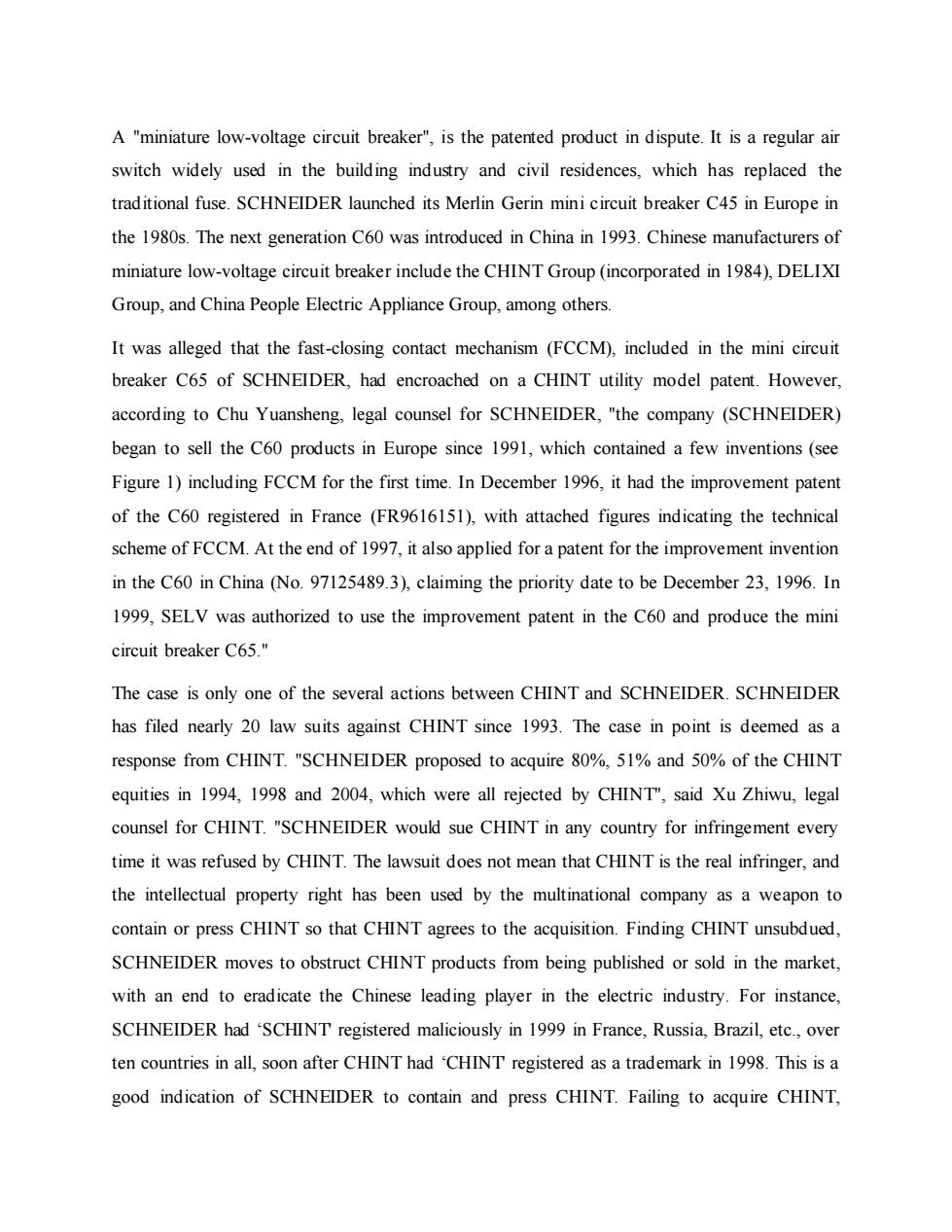
A "miniature low-voltage circuit breaker",is the patented product in dispute.It is a regular air switch widely used in the building industry and civil residences.which has replaced the traditional fuse.SCHNEIDER launched its Merlin Gerin mini circuit breaker C45 in Europe in the 1980s.The next generation C60 was introduced in China in 1993.Chinese manufacturers of miniature low-voltage circuit breaker include the CHINT Group(incorporated in 1984),DELIXI Group,and China People Electric Appliance Group,among others. It was alleged that the fast-closing contact mechanism (FCCM).included in the mini circuit breaker C65 of SCHNEIDER,had encroached on a CHINT utility model patent.However, according to Chu Yuansheng.legal counsel for SCHNEIDER,"the company (SCHNEIDER) began to sell the C60 products in Europe since 1991,which contained a few inventions (see Figure 1)including FCCM for the first time.In December 1996,it had the improvement patent of the C60 registered in France (FR9616151),with attached figures indicating the technical scheme of FCCM.At the end of 1997,it also applied for a patent for the improvement invention in the C60 in China (No.97125489.3),claiming the priority date to be December 23,1996.In 1999.SELV was authorized to use the improvement patent in the C60 and produce the mini circuit breaker C65." The case is only one of the several actions between CHINT and SCHNEIDER.SCHNEIDER has filed nearly 20 law suits against CHINT since 1993.The case in point is deemed as a response from CHINT."SCHNEIDER proposed to acquire 80%,51%and 50%of the CHINT equities in 1994,1998 and 2004,which were all rejected by CHINT",said Xu Zhiwu,legal counsel for CHINT."SCHNEIDER would sue CHINT in any country for infringement every time it was refused by CHINT.The lawsuit does not mean that CHINT is the real infringer,and the intellectual property right has been used by the multinational company as a weapon to contain or press CHINT so that CHINT agrees to the acquisition.Finding CHINT unsubdued, SCHNEIDER moves to obstruct CHINT products from being published or sold in the market, with an end to eradicate the Chinese leading player in the electric industry.For instance. SCHNEIDER had 'SCHINT registered maliciously in 1999 in France,Russia,Brazil,etc.,over ten countries in all,soon after CHINT had CHINT registered as a trademark in 1998.This is a good indication of SCHNEIDER to contain and press CHINT.Failing to acquire CHINT
A "miniature low-voltage circuit breaker", is the patented product in dispute. It is a regular air switch widely used in the building industry and civil residences, which has replaced the traditional fuse. SCHNEIDER launched its Merlin Gerin mini circuit breaker C45 in Europe in the 1980s. The next generation C60 was introduced in China in 1993. Chinese manufacturers of miniature low-voltage circuit breaker include the CHINT Group (incorporated in 1984), DELIXI Group, and China People Electric Appliance Group, among others. It was alleged that the fast-closing contact mechanism (FCCM), included in the mini circuit breaker C65 of SCHNEIDER, had encroached on a CHINT utility model patent. However, according to Chu Yuansheng, legal counsel for SCHNEIDER, "the company (SCHNEIDER) began to sell the C60 products in Europe since 1991, which contained a few inventions (see Figure 1) including FCCM for the first time. In December 1996, it had the improvement patent of the C60 registered in France (FR9616151), with attached figures indicating the technical scheme of FCCM. At the end of 1997, it also applied for a patent for the improvement invention in the C60 in China (No. 97125489.3), claiming the priority date to be December 23, 1996. In 1999, SELV was authorized to use the improvement patent in the C60 and produce the mini circuit breaker C65." The case is only one of the several actions between CHINT and SCHNEIDER. SCHNEIDER has filed nearly 20 law suits against CHINT since 1993. The case in point is deemed as a response from CHINT. "SCHNEIDER proposed to acquire 80%, 51% and 50% of the CHINT equities in 1994, 1998 and 2004, which were all rejected by CHINT", said Xu Zhiwu, legal counsel for CHINT. "SCHNEIDER would sue CHINT in any country for infringement every time it was refused by CHINT. The lawsuit does not mean that CHINT is the real infringer, and the intellectual property right has been used by the multinational company as a weapon to contain or press CHINT so that CHINT agrees to the acquisition. Finding CHINT unsubdued, SCHNEIDER moves to obstruct CHINT products from being published or sold in the market, with an end to eradicate the Chinese leading player in the electric industry. For instance, SCHNEIDER had ‘SCHINT' registered maliciously in 1999 in France, Russia, Brazil, etc., over ten countries in all, soon after CHINT had ‘CHINT' registered as a trademark in 1998. This is a good indication of SCHNEIDER to contain and press CHINT. Failing to acquire CHINT
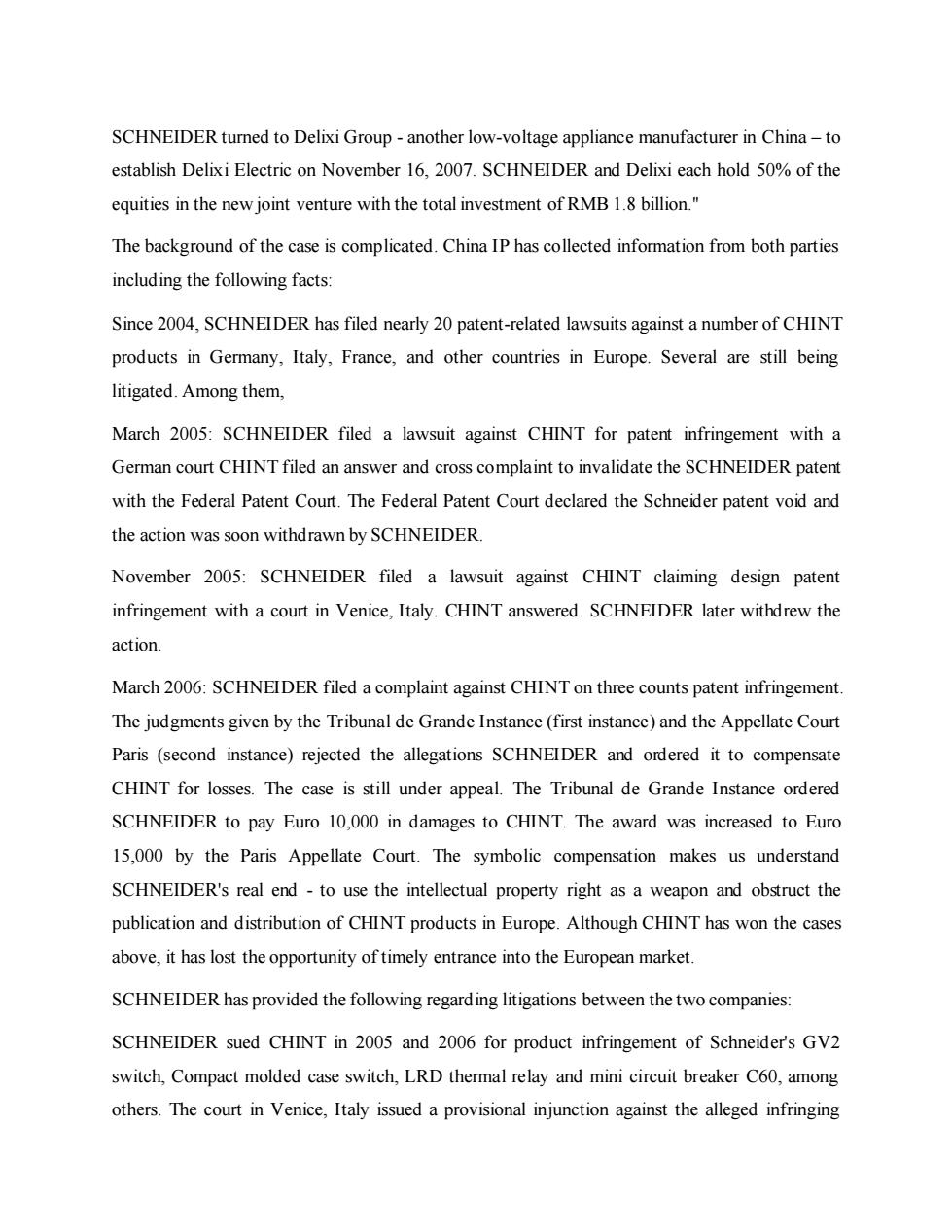
SCHNEIDER turned to Delixi Group-another low-voltage appliance manufacturer in China-to establish Delixi Electric on November 16,2007.SCHNEIDER and Delixi each hold 50%of the equities in the new joint venture with the total investment of RMB1.8 billion. The background of the case is complicated.China IP has collected information from both parties including the following facts: Since 2004.SCHNEIDER has filed nearly 20 patent-related lawsuits against a number of CHINT products in Germany,Italy,France,and other countries in Europe.Several are still being litigated.Among them March 2005:SCHNEIDER filed a lawsuit against CHINT for patent infringement with a German court CHINT filed an answer and cross complaint to invalidate the SCHNEIDER patent with the Federal Patent Court.The Federal Patent Court declared the Schneider patent void and the action was soon withdrawn by SCHNEIDER. November 2005:SCHNEIDER filed a lawsuit against CHINT claiming design patent infringement with a court in Venice,Italy.CHINT answered.SCHNEIDER later withdrew the action. March 2006:SCHNEIDER filed a complaint against CHINT on three counts patent infringement. The judgments given by the Tribunal de Grande Instance(first instance)and the Appellate Court Paris (second instance)rejected the allegations SCHNEIDER and ordered it to compensate CHINT for losses.The case is still under appeal.The Tribunal de Grande Instance ordered SCHNEIDER to pay Euro 10,000 in damages to CHINT.The award was increased to Euro 15,000 by the Paris Appellate Court.The symbolic compensation makes us understand SCHNEIDER's real end-to use the intellectual property right as a weapon and obstruct the publication and distribution of CHINT products in Europe.Although CHINT has won the cases above,it has lost the opportunity oftimely entrance into the European market. SCHNEIDER has provided the following regarding litigations between the two companies SCHNEIDER sued CHINT in 2005 and 2006 for product infringement of Schneider's GV2 switch,Compact molded case switch,LRD thermal relay and mini circuit breaker C60,among others.The court in Venice,Italy issued a provisional injunction against the alleged infringing
SCHNEIDER turned to Delixi Group - another low-voltage appliance manufacturer in China – to establish Delixi Electric on November 16, 2007. SCHNEIDER and Delixi each hold 50% of the equities in the new joint venture with the total investment of RMB 1.8 billion." The background of the case is complicated. China IP has collected information from both parties including the following facts: Since 2004, SCHNEIDER has filed nearly 20 patent-related lawsuits against a number of CHINT products in Germany, Italy, France, and other countries in Europe. Several are still being litigated. Among them, March 2005: SCHNEIDER filed a lawsuit against CHINT for patent infringement with a German court CHINT filed an answer and cross complaint to invalidate the SCHNEIDER patent with the Federal Patent Court. The Federal Patent Court declared the Schneider patent void and the action was soon withdrawn by SCHNEIDER. November 2005: SCHNEIDER filed a lawsuit against CHINT claiming design patent infringement with a court in Venice, Italy. CHINT answered. SCHNEIDER later withdrew the action. March 2006: SCHNEIDER filed a complaint against CHINT on three counts patent infringement. The judgments given by the Tribunal de Grande Instance (first instance) and the Appellate Court Paris (second instance) rejected the allegations SCHNEIDER and ordered it to compensate CHINT for losses. The case is still under appeal. The Tribunal de Grande Instance ordered SCHNEIDER to pay Euro 10,000 in damages to CHINT. The award was increased to Euro 15,000 by the Paris Appellate Court. The symbolic compensation makes us understand SCHNEIDER's real end - to use the intellectual property right as a weapon and obstruct the publication and distribution of CHINT products in Europe. Although CHINT has won the cases above, it has lost the opportunity of timely entrance into the European market. SCHNEIDER has provided the following regarding litigations between the two companies: SCHNEIDER sued CHINT in 2005 and 2006 for product infringement of Schneider's GV2 switch, Compact molded case switch, LRD thermal relay and mini circuit breaker C60, among others. The court in Venice, Italy issued a provisional injunction against the alleged infringing